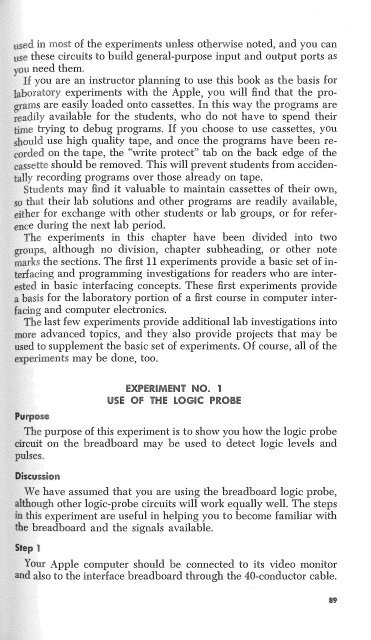You also want an ePaper? Increase the reach of your titles
YUMPU automatically turns print PDFs into web optimized ePapers that Google loves.
in most of the experiments unless other.vise noted, and you can<br />
these circuits to build general-purpose input and output ports as<br />
need them.<br />
If you are an instructor planning to use this book as the basis for<br />
boratory experiments with the Apple, you will find that the proms<br />
are easily loaded onto cassettes. In this way the programs are<br />
adily available for the students, who do not have to spend their<br />
me trying to debug programs. If you choose to use cassettes, you<br />
ould use high quality tape, and once the programs have been rerded<br />
on the tape, the "write protect" tab on the back edge of the<br />
assette should be removed. This will prevent students from accidenlly<br />
recording programs over those already on tape.<br />
Students may find it valuable to maintain cassettes of their own,<br />
that their lab solutions and other programs are readily available,<br />
her for exchange with other students or lab groups, or for refere<br />
during the next lab period.<br />
The experiments in this chapter have been divided into two<br />
groups, although no division, chapter subheading, or other note<br />
J'narks the sections. The first 11 experiments provide a basic set of inierfacing<br />
and programming investigations for readers who are intered<br />
in basic <strong>interfacing</strong> concepts. These first experiments provide<br />
basis for the laboratory portion of a first course in computer intercing<br />
and computer electronics.<br />
The last few experiments provide additional lab investigations into<br />
advanced topics, and they also provide projects that may be<br />
'":"'"'''°,._,to supplement the basic set of experiments. Of course, all of the<br />
1kperiments may be done, too.<br />
rpo!le<br />
EXPERIMtNT NO. 1<br />
USE Of THIE lOGIC PROBE<br />
The purpose of this experiment is to show you how the logic probe<br />
uit on the breadboard may be used to detect logic levels and<br />
e have assumed that you are using the breadboard logic probe,<br />
ough other logic-probe circuits will work equally well. The steps<br />
this experiment are useful in helping you to become familiar with<br />
breadboard and the signals available.<br />
Apple computer should be connected to its video monitor<br />
also to the interface breadboard through the 40-conductor cable.

















